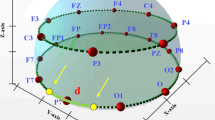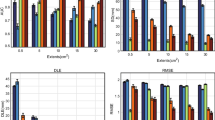Abstract
The electroencephalogram (EEG) signal is one of the most frequently used biomedical signals. In order to accurately exploit the cosparsity and low-rank property which is nature in multichannel EEG signals, motivated by the fact that weighted schatten-p norm and \({l_q}\) norm can better approximate the matrix rank and \({l_0}\) norm, in this paper, a non-convex optimization model is proposed to precisely reconstruct the multichannel EEG signal. weighted schatten-p norm and \({l_q}\) norm are used to enforce low-rank property and cosparsity. In addition, an efficient iterative optimization method based on alternating direction method of multipliers is used to solve the resulting non-convex optimization problem. Experimental results have demonstrated that the proposed algorithm can significantly outperform existing state-of-the-art CS methods for compressive sensing of multichannel EEG signals.




Similar content being viewed by others
References
Abdulghani AM, Casson AJ, Rodriguez-Villegas E (2012) Compressive sensing scalp EEG signals: implementations and practical performance. Med Biol Eng Comput 50(11):1137–1145
Bhardwaj A, Raman S (2016) Robust PCA-based solution to image composition using augmented Lagrange multiplier (ALM). Vis Comput 32(5):591–600
Boyd S, Parikh N, Chu E, Peleato B, Eckstein J (2010) Distributed optimization and statistical learning via the alternating direction method of multipliers. Found Trends Mach Learn 3(1):1–122
Casson AJ, Yates D, Smith S, Duncan JS (2010) Wearable electroencephalography. IEEE Eng Med Biol Mag 29(3):44–56
Chartrand R, Yin W (2008) Iteratively reweighted algorithms for compressive sensing. In: IEEE international conference on acoustics
Coltuc D (2015) Introduction to compressive sampling and applications in THZ imaging. In: Proceedings of SPIE, The International Society for Optical Engineering, vol 9258
Donoho DL (2006) Compressed sensing. IEEE Trans Inf Theory 52(4):1289–1306
Goldberger AL, Amaral LA, Glass L, Hausdorff JM, Ivanov PC, Mark RG, Mietus JE, Moody GB, Peng CK, Stanley HE (2000) Physiobank, physiotoolkit, and physionet: components of a new research resource for complex physiologic signals. Circulation 101(23):E215
Gong C, Tao D, Chang X, Yang J (2018) Ensemble teaching for hybrid label propagation. IEEE Trans Cybern PP(99):1–15
Gong C, Tao D, Liu W, Liu L, Yang J (2017) Label propagation via teaching-to-learn and learning-to-teach. IEEE Trans Neural Netw Learn Syst 28(6):1452–1465
Gong C, Tao D, Maybank SJ, Liu W, Kang G, Yang J (2016) Multi-modal curriculum learning for semi-supervised image classification. IEEE Trans Image Process 25(7):3249–3260
Gu S, Xie Q, Meng D, Zuo W, Feng X, Zhang L (2017) Weighted nuclear norm minimization and its applications to low level vision. Int J Comput Vis 121(2):183–208
Hosseini SA, Khalilzadeh MA (2010) Emotional stress recognition system using EEG and psychophysiological signals: using new labelling process of EEG signals in emotional stress state. In: International conference on biomedical engineering & computer science
Jing W, Meng W, Hu X, Yan S (2015) Visual data denoising with a unified schatten-p norm and q norm regularized principal component pursuit. Pattern Recognit 48(10):3135–3144
Jovanov E, Milenkovic A, Otto C, Groen PCD (2005) A wireless body area network of intelligent motion sensors for computer assisted physical rehabilitation. J Neuroeng Rehabil 2(1):6–6
Lei F, Sun H, Sun Q, Xia G (2016) Blind compressive sensing using block sparsity and nonlocal low-rank priors. J Vis Commun Image Represent 42:37–45
Lei F, Sun H, Sun Q, Xia G (2016) Image compressive sensing via truncated schatten-p norm regularization. Sig Process Image Commun 47:S0923596516300, 790
Liu Y, De VM, Huffel SV (2015) Compressed sensing of multi-channel EEG signals: the simultaneous cosparsity and low rank optimization. IEEE Trans Biomed Eng 62(8):2055–2061
Nam S, Davies ME, Elad M, Gribonval R (2013) The cosparse analysis model and algorithms. Appl Comput Harmon Anal 34(1):30–56
Rao BD, Kreutz-Delgado K (1999) An affine scaling methodology for best basis selection. IEEE Trans Signal Process 47(1):187–200
Sahoo SK, Makur A (2015) Signal recovery from random measurements via extended orthogonal matching pursuit. IEEE Trans Signal Process 63(10):2572–2581
Shu X, Yang J, Ahuja N (2014) Non-local compressive sampling recovery. In: IEEE international conference on computational photography
Wang Q, Liu Z (2011) Sampling matrix perturbation analysis of subspace pursuit for compressive sensing. In: Information & automation-international symposium
Weisheng D, Guangming S, Xin L, Yi M, Feng H (2014) Compressive sensing via nonlocal low-rank regularization. IEEE Trans Image Process A Publ IEEE Signal Process Soc 23(8):3618–32
Wipf DP, Rao BD (2007) An empirical Bayesian strategy for solving the simultaneous sparse approximation problem. IEEE Trans Signal Process 55(7):3704–3716
Yamagishi M, Yamada I (2011) Over-relaxation of the fast iterative shrinkage-thresholding algorithm with variable stepsize. Inverse Probl 27(10):105,008–105,022(15)
Yipeng L, Maarten DV, Ivan G, Vladimir M, Yuqian L, Sabine VH (2013) Multi-structural signal recovery for biomedical compressive sensing. IEEE Trans Biomed Eng 60(10):2794–2805
Zhang T, Tang Z, Liu Q (2017) Robust subspace clustering via joint weighted schatten-p norm and \({l_q}\) norm minimization. J Electron Imaging 26(3):033,021
Zhilin Z, Tzyy-Ping J, Scott M, Rao BD (2013) Compressed sensing of EEG for wireless telemonitoring with low energy consumption and inexpensive hardware. IEEE Trans Biomed Eng 60(1):221–224
Zhou W, Bovik AC (2009) Mean squared error: love it or leave it? A new look at signal fidelity measures. IEEE Signal Process Mag 26(1):98–117
Acknowledgements
The authors would like to express their gratitude to the anonymous referees as well as the Editor and Associate Editor for their valuable comments which lead to substantial improvements of the paper. This work was supported by China National Critical Project for Science and Technology on Water Pollution Prevention and Control, No. 2017ZX07104001, the Natural Science Fund for Colleges and Universities in Jiangsu Province, Grant No. 16KJB520014 and the Jiangsu Key Laboratory of Image and Video Understanding for Social Safety (Nanjing University of Science and Technology), Grant No. 30916014107.
Author information
Authors and Affiliations
Corresponding author
Additional information
Publisher's Note
Springer Nature remains neutral with regard to jurisdictional claims in published maps and institutional affiliations.
Rights and permissions
About this article
Cite this article
Chen, C., Zhou, X. A Non-convex Optimization Model for Signal Recovery. Neural Process Lett 54, 3529–3536 (2022). https://doi.org/10.1007/s11063-020-10253-4
Published:
Issue Date:
DOI: https://doi.org/10.1007/s11063-020-10253-4




